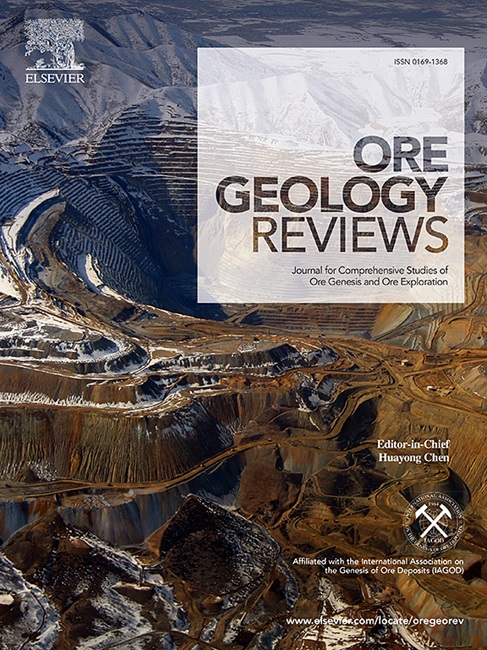Sn and W mineralisation in the Iberian Peninsula
IF 3.2
2区 地球科学
Q1 GEOLOGY
引用次数: 0
Abstract
This paper provides a comprehensive review and a refined classification of Sn-W mineralisation in the Iberian Peninsula, based on an extensive review of the available literature. The study synthesises and clarifies previously published information to improve the understanding of the mineralisation processes and their tectonic and magmatic controls. The Sn and W mineralisation in the Iberian Peninsula exhibit a strong correlation with specific granitic suites primarily formed during the late to post-Variscan orogeny. Structural controls, particularly syn- to late-D3 strike-slip and/or extensional structures developed during the tectonic regime of the late Variscan, appear to be pivotal to facilitate the emplacement of this water-rich granitic magmas, that otherwise would have stalled at deeper environments, and the development of extensive hydrothermal systems. Two main mineralisation styles are identified: Sn-(Nb-Ta-Li) mineralisation under lithostatic pressure conditions, characterised by disseminated cassiterite in some pegmatites and altered granitic cupolas; and Sn-(Nb-Ta-Li) and W-(Sn) deposits formed at shallower levels within the brittle regime. The Sn-(Nb-Ta-Li) mineralisation is primarily associated with S-type granitic intrusions, while the W-(Sn) mineralisation also tends to be linked to these granitic suites, although several W-rich but Sn-poor deposits appear related to I-type granitoids. The metal enrichment in these magmas is likely due to a combination of inheritance from the source of the protoliths and magmatic evolution processes. The observed decoupling between Sn-rich and W-poor deposits versus W-(Sn)-rich deposits suggests contrasting behaviours of W and Sn during magmatic transport, the magmatic-hydrothermal transition, and the subsequent hydrothermal transport and deposition. Both types of deposits likely represent different settings and/or stages within a single magmatic-hydrothermal system.

伊比利亚半岛的锡、钨矿化
本文在对现有文献进行广泛回顾的基础上,对伊比利亚半岛的锡钨矿化进行了全面回顾和精细分类。该研究综合和澄清了先前发表的信息,以提高对矿化过程及其构造和岩浆控制的理解。伊比利亚半岛的锡、钨矿化与主要形成于晚-后瓦里斯坎造山运动时期的特定花岗质套有很强的相关性。构造控制,特别是在晚瓦立斯坎构造体系中发育的顺-晚d3走滑和/或伸展构造,似乎是促进富水花岗岩岩浆侵位的关键,否则这些岩浆将在更深的环境中停滞不前,并促进广泛的热液系统的发展。确定了两种主要的成矿类型:在静压条件下的锡-(铌-钽-锂)成矿,其特征是部分伟晶岩中的浸染锡石和蚀变花岗质冲天炉;Sn-(Nb-Ta-Li)和W-(Sn)矿床形成于较浅的脆性区。Sn-(Nb-Ta-Li)矿化主要与s型花岗岩体有关,而W-(Sn)矿化也倾向于与这些花岗岩体有关,尽管一些富W贫Sn矿床似乎与i型花岗岩体有关。这些岩浆中的金属富集可能是原岩源继承和岩浆演化过程共同作用的结果。富锡贫锡矿床与富锡W-(Sn)矿床之间的解耦表明,在岩浆运输、岩浆-热液转变以及随后的热液运输和沉积过程中,W和Sn的行为截然不同。这两种类型的矿床可能代表了同一岩浆热液系统内不同的环境和/或阶段。
本文章由计算机程序翻译,如有差异,请以英文原文为准。
求助全文
约1分钟内获得全文
求助全文
来源期刊

Ore Geology Reviews
地学-地质学
CiteScore
6.50
自引率
27.30%
发文量
546
审稿时长
22.9 weeks
期刊介绍:
Ore Geology Reviews aims to familiarize all earth scientists with recent advances in a number of interconnected disciplines related to the study of, and search for, ore deposits. The reviews range from brief to longer contributions, but the journal preferentially publishes manuscripts that fill the niche between the commonly shorter journal articles and the comprehensive book coverages, and thus has a special appeal to many authors and readers.
 求助内容:
求助内容: 应助结果提醒方式:
应助结果提醒方式:


